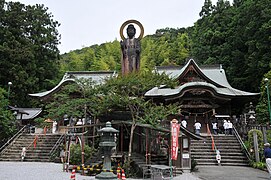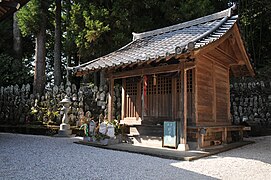Kiyotaki-ji (Tosa)
The Kiyotaki-ji ( Japanese 清 瀧 寺 ), with the Go Iōzan (醫 王 山) and Kyōchiin (鏡 池 院) in the city of Tosa ( Kōchi Prefecture ), is a temple of the Buzan branch (豊 山 派) of Shingon Buddhism . In the traditional count, it is the 35th temple on the Shikoku pilgrimage route .
history
According to tradition, priest Gyōki passed here on his pilgrimage in Yōrō 7 (723) and felt that this was a sacred place. Then he made a sculpture of the healing Buddha, the Yakushi ( 薬 師 如 来 ). For the Yakishi he built a temple complex, which he called "Eizanmitsu-in" ( 影 山 密 院 ) or "Ekimoku-ji" ( 繹 木 寺 ). - The visit of Priest Kūkai 100 years later fell in the Kōnin years 810 to 824. He erected an altar about 300 m away on the top of the local mountain and spent 17 days praying there. On the last day he stabbed the altar with a golden staff, whereupon a spring of clear water gushed out of a rock and filled a mirror-smooth pond. This water flowed down the mountain, irrigating the fields where bushes grew from which Mitsumata Japanese paper could be made.
According to tradition, Prince Takaoka ( 高 岳 親王 ; Takaoka Shinnō) came to the temple for ascetic exercises in the year 861 before his trip to China. Takaoka was the third son of Emperor Hiezei and was actually intended as his successor with the accession to the throne of Emperor Saga in 809 , but lost this position in the incident around Kusuko ( 薬 子 の 変 , Kusuko no hen). He later turned to the secret traditions of the Shingon. To learn its basics, he went to China and came through the province of Tosa. A stone stupa in the thicket below the temple commemorates the visit, but since the thicket was declared "not accessible" ( 不入 山 , Irazu yama), the memorial cannot be visited.
In the Edo period , the princes of Tosa, the Yamanouchi , supported the temple with a donation of several hundred seki and had it expanded so that it was one of the great temples of Tosa. The oversized statue of Yakushi Nyorai has become a symbol of the fact that a prayer at the temple can avert disaster.
investment
On the way to the temple you pass the temple gate, which is designed here as a Niō gate (仁王 門), i.e. as a gate with space for the two temple guards to the right and left of the passage. Then there is a long flight of stairs until one reaches the temple area after crossing a street. After a few more steps you have reached the lower level. On the right is the bell tower (鐘楼, Shōrō; 4), ahead you can see the main hall (本 堂, Hondō; 1) to which you have to climb one last flight of stairs. To the left of the main hall is the hall dedicated to the temple founder, the Daishidō (大師 堂; 2) and on the far left the Kannon Pavilion (観 音 堂; 3). Both the main hall and the Daishidō show a curved gable section in the "Chinese style" (唐 破 風, Karahafu) on the front side, which is common in Japan in the 17th and 18th centuries.
To the right of the main hall is a pavilion with the Mizuko Jizō (水 子 地 蔵; 5), i.e. the holy Jizō, to whom asks for miscarriages or aborted children. Even further to the right is the Kotote Shrine (琴 手 神社; 5).
The sculpture of Yakushi, who averted the danger and towered over the temple complex, was donated by a paper manufacturer in 1932. It is 15 m high with a base, with 11 by 8 steps leading to the base, which surround it in a circle.
Treasures
The main cult figure, a standing Yakushi (薬 師 如 来 立 像, Yakushi Nyorai ritsuzō) is 154 cm high and is registered as an important cultural asset of Japan . Other treasures include a bronze mirror (銅 造 鏡像, Dōzō Kyōzō) and three kakehotoke (懸 仏), which are disks with a seated Buddha figure. The four discs, which are registered as a cultural asset of the prefecture, have a diameter of 15 to 30 cm and were made from the Heina to the Muromachi period .
photos
literature
- Kōchi-ken kotogakko kyoiku kenkyukai rekishi bukai (Ed.): Kiyotaki-ji . In: Kōchi-ken no rekishi sampo. Yamakawa Shuppan, 2006, ISBN 978-4-634-24639-3 , pages 222 and 244.
- Oguri, Doei: Kukai. Shikoku hachijuhachi kosho no arukikata. Chukei no Bunko, 2011, ISBN 978-4-8061-4067-2 .
Web links
Coordinates: 33 ° 30 ′ 45 " N , 133 ° 24 ′ 34.2" E







